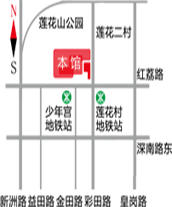
- "On the Road · 2015: China Youth Artists' Works Nomination Exhibition and Critics Forum"
-

Click to view Exhibition Name: "On the Road · 2015: Nomination Exhibition and Critics Forum for Chinese Young Artists' Works"
Exhibition period: October 24th to November 17th, 2015
Hosted by: Shenzhen Guan Shanyue Art Museum, China Artists Association Curatorial Committee
Special Fund Support Project for the Development of Propaganda and Culture in Shenzhen
The Chinese New Art Movement has been going on for over 30 years now. Over the past 30 years, with the transformation of the economic and cultural environment on which art relies for survival, artistic concepts and forms have also undergone changes. From a historical perspective, these 30 years precisely reflect the process of self-discipline in contemporary Chinese art and the constant game between various factors outside of art, and the special era has given birth to extraordinary contemporary Chinese art. Some people say that the era of contemporary art creating myths has passed, implying that art should return to its true order. However, over 30 years of crowded ideological trends and noisy concepts are enveloped by various artistic events, just like Kiecher's "Mirror House". Only with a direct blow to oneself can one break the illusion and return to the real world. The 70s and 80s generations are the generation of artists who grew up in this "mirror house". Their artistic creations are a turning point for the return of contemporary Chinese art from the "big era" to the "small era", and "on the road" is not only their collective memory of youth, but also the core of their outlook on life and values. As presented in their creations, "on the road" is not only a state, but also an attitude!
The concepts of the post-70s and post-80s generations first appeared in the poetry industry and subsequently sparked widespread debate throughout the literary world. They have given extensive attention to the pioneering role of the post-70s and post-80s writing groups and their fleeting cultural motivations, as well as how "intergenerational logic" emerged and how it was resolved. Although there was no similar phenomenon among the post-70s and post-80s generation in the art industry during the same period, the transitional differences between their creative groups and their predecessors in terms of survival status, knowledge structure, academic background, and creative status are self-evident. A new art ecology that reflects their attitude towards life, aesthetic concepts, and academic direction has quietly formed. Of course, the novelty of the new art ecosystem cannot be denied for its continuation and continuation of tradition, especially the academic context and rules formed since 1985. So, what kind of concept, form, and ecology does the new art ecology present? Where is the new manifestation of new art? What is the turning point of its significance in the development of contemporary art? This is the topic that we intend to focus on and discuss in our series of academic activities.
It should be noted that the presentation of art is certainly related to an era, and artists in the same period must have certain similarities in cultural attention and work presentation. However, artistic creation, especially in the contemporary context, is more about the individual's inner self and endowment. Therefore, it is difficult and impossible for us to make a unified value judgment for a generation with a concept first holistic thinking. Instead, we must connect individuals with node significance through the chain of history to achieve a sensory and objective presentation. At the same time, historical writing without a certain examination distance is inevitably not objective enough. Therefore, although this series of academic activities is aimed at accumulating historical knowledge, it is not dedicated to drawing any historical conclusions. Instead, it strives to present vivid artistic problems in the current comparative collection from the perspective of experienced individuals, and provide certain clues for the writing of art history through the analysis and interpretation of problems. So compared to the many avant-garde biennials and biennials, this series of academic activities emphasizes more on the documentary nature of the content. I hope this series of activities is not only a process of historical review and artistic presentation, but also a process of knowledge production.
It should be noted that the presentation of art is certainly related to an era, and artists in the same period must have certain similarities in cultural attention and work presentation. However, artistic creation, especially in the contemporary context, is more about the individual's inner self and endowment. Therefore, it is difficult and impossible for us to make a unified value judgment for a generation with a concept first holistic thinking. Instead, we must connect individuals with node significance through the chain of history to achieve a sensory and objective presentation. At the same time, historical writing without a certain examination distance is inevitably not objective enough. Therefore, although this series of academic activities is aimed at accumulating historical knowledge, it is not dedicated to drawing any historical conclusions. Instead, it strives to present vivid artistic problems in the current comparative collection from the perspective of experienced individuals, and provide certain clues for the writing of art history through the analysis and interpretation of problems. So compared to the many avant-garde biennials and biennials, this series of academic activities emphasizes more on the documentary nature of the content. I hope this series of activities is not only a process of historical review and artistic presentation, but also a process of knowledge production.
Printmaking is a type of media that maintains a good synchronous relationship with the development process of the current society and era. The era context of "post printing" has not only had an important impact on the ecology and form of its art, but also provided infinite possibilities for its contemporary development. Moreover, due to the indirect and plural nature of printmaking, the state presented and the problems faced in the current context are more typical. So, in the context of contemporary culture, what is the state and ecology of printmaking? What are the practical manifestations and root causes of the long-standing academic demands for media expansion? Setting aside the traditional identity of printmaking and restoring its essence as a medium, how to view the "cross-border" and "boundary" of printmaking? Has "delineation" fundamentally solved the problem of "contemporaneity" in printmaking? What is the relationship between the contemporaneity of media and the media in contemporary art? How contemporary printmaking can retain the warmth of "hands" in the digital virtual space of light and shadow interweaving will be the focus and discussion of this "On the Road" event.
-
2015-10-24



